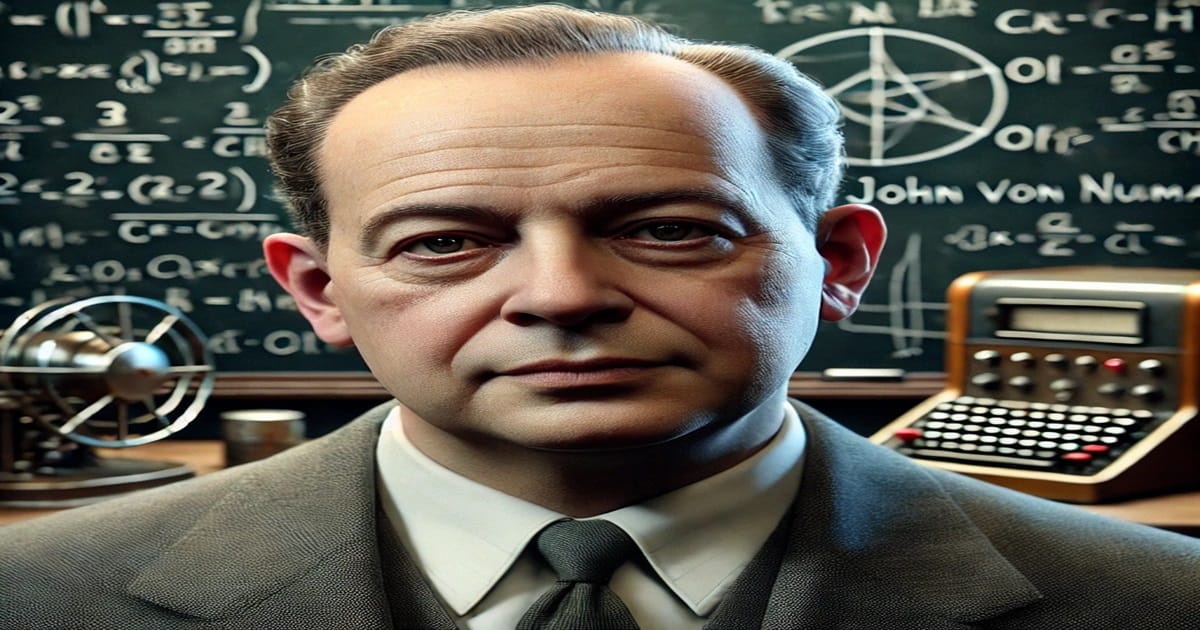The Great Computer Age
John von Neumann (1903–1957) was a pioneering figure whose brilliance shaped the trajectory
of modern science and technology. Born in Budapest, Hungary, he emerged as one of the
20th century’s foremost polymaths, excelling in fields from mathematics and physics to
game theory and meteorology. However, his most far-reaching contribution may be his
invention of the stored-program concept—the notion that instructions
(i.e., software) could reside in the same memory as data, allowing machines to transform
their functions with ease. This universal approach to computing echoes through every
device we use today, from immense supercomputers to compact mini PCs
that handle multitasking on our desks.
Yet von Neumann’s genius extended well beyond computing architecture. He elucidated
the underpinnings of quantum theory, founded the mathematical discipline of game theory,
and spearheaded efforts to model weather numerically. In each sphere, he unified
pure mathematics with hands-on problem-solving, exemplifying a rare intellect
unafraid to tackle the unknown. This article explores his life, the key principles
he introduced, and how they continue to reverberate in modern technologies,
highlighting the synergy of logic, engineering, and imagination that defines
the “Father of the Great Computer Age.”
1. Budapest Beginnings
1.1 A Prodigy Takes Shape
Von Neumann was born Neumann János Lajos in Budapest on December 28, 1903.
From an early age, his prodigious memory and arithmetic powers astounded onlookers.
By eight, he had surpassed what most consider advanced high school math,
impressing even seasoned mentors with his rapid-fire mental calculations.
Budapest itself was a vibrant intellectual center, home to numerous future
Nobel laureates. This dynamic backdrop encouraged his curiosity across
mathematics, history, languages, and physics, fueling a holistic worldview
that transcended rigid academic boundaries.
As a teenager, von Neumann studied chemical engineering in tandem with advanced math,
gaining a unique blend of theoretical insight and practical problem-solving.
He quickly earned recognition among Europe’s intellectual elite, publishing papers
on set theory before most students complete their bachelor’s degrees. This
combination of rigorous math with an appetite for real-world applications
would soon point him toward groundbreaking contributions in emerging fields—most
notably in digital computation and logic.
1.2 Crossing the Atlantic
Mounting political tensions and the approach of war prompted von Neumann to accept
opportunities in the United States. By the 1930s, Princeton University and the
newly formed Institute for Advanced Study (IAS) welcomed him, recognizing his
multidisciplinary brilliance. At Princeton, he shared intellectual space with
Albert Einstein and other leading figures, adding impetus to his cross-field
interests in physics, engineering, and computing.
During WWII, von Neumann advised U.S. government projects on ballistic calculations,
cryptography, and nuclear research. This melding of pure math with pressing
wartime needs set the stage for his next, greatest idea: universal computers
capable of adapting to any program. He saw no contradiction in applying
rigorous logic to real-world challenges, forging an environment where
theoretical constructs could solve tangible problems—an approach that resonates
through modern HPC (High-Performance Computing) and the flexible software
architectures we take for granted today.
2. Stored-Program Concept: The Digital Turning Point
2.1 From Fixed Circuits to Universal Software
Before von Neumann’s work, electronic computers like ENIAC were essentially
fixed-circuit calculators. Rewiring them for fresh tasks was cumbersome.
Von Neumann upended this with his stored-program architecture,
an elegant scheme where instructions (software) and data share the same memory.
This unifying concept quickly replaced rigid rewiring, enabling a single machine
to handle myriad tasks by merely loading different programs.
The “von Neumann architecture” formally partitions a computer into
memory, control unit, arithmetic logic unit (ALU), and input/output systems—
but its real coup was the ability to pivot function almost instantly.
We see this today in the mass personalization of devices: laptops, workstations,
and especially mini PCs, which can morph from office productivity
to streaming media or gaming tasks, all thanks to the flexible, stored-program
foundation. The typical “fetch-decode-execute” cycle at the heart of each CPU
traces back to von Neumann’s conceptual leap.
Table: The Von Neumann Architecture at a Glance
| Component | Role | Modern Counterpart |
|---|---|---|
| Memory | Holds both instructions & data | RAM (DDR4 or DDR5 SDRAM) in PCs, servers |
| Control Unit | Fetches/decodes instructions | CPU instruction pipeline |
| ALU | Executes computations & logic | CPU core (integer & floating-point units) |
| I/O Subsystems | Facilitates user or peripheral interaction | GPU ports, USB, networking |
2.2 Conceptual Graph: Explosion of Stored-Program Machines
Timeline of Universal Computing Adoption
A hypothetical chart might show minimal adoption in the 1950s, expanding to minicomputers in the 1970s, personal PCs in the 1980s, laptops and HPC in the 1990s, and culminating in billions of mobile devices and mini PCs today.
1970s–80s: Minicomputers, Apple II, IBM PC
1990s–2000s: Laptops, smartphones, HPC clusters
2010–Present: mini PCs, IoT devices, cloud servers
[Approx. Data: Exponential increase per decade in stored-program systems, shaping consumer electronics and enterprise solutions worldwide.]
3. Game Theory, Quantum Mechanics, and Weather Modeling
3.1 Game Theory: Math for Strategic Decisions
Von Neumann teamed with economist Oskar Morgenstern to develop game theory,
formally examining competitive and cooperative interactions through mathematical
models. The results, outlined in Theory of Games and Economic Behavior,
sparked a revolution in how economists and political scientists view negotiation,
resource allocation, and conflict resolution. Ideas like minimax strategies and
Nash equilibria (later refined by John Nash) owe foundational logic to von Neumann.
Today, game theory thrives in AI, automating strategies for everything from
auction algorithms to scheduling tasks in distributed systems. This synergy
between logic and real-world complexity typifies von Neumann’s style:
embedding rigorous math in practical frameworks that solve pressing
problems — whether it’s setting optimal stock portfolios or designing
robust AI for strategic board games.
Gaming DDR4 Mini PC
Gaming DDR5 Mini PC
3.2 Quantum Operator Algebras
While forging new paths in computing, von Neumann also made decisive
contributions to quantum mechanics. In his Mathematical
Foundations of Quantum Mechanics, he set forth operator algebra formalisms
that clarified how observers, measurements, and wavefunctions intersect.
This rigor alleviated confusion in a field known for paradoxes and
probabilistic insights, shaping the still-evolving discipline of
quantum computing.
His operator-theoretic approach continues to guide physicists in
understanding entanglement and measurement outcomes, bridging the
gap between intangible math and tangible experiment. Many suspect
he would be enthralled by modern quantum information projects,
where the concept of a “universal machine” evolves to handle qubits
in superposition rather than just binary bits.
3.3 Weather Forecasting: From Hunch to HPC
Before von Neumann, meteorology was largely a matter of pattern recognition
and local guesswork. He advocated using early digital computers (like ENIAC)
to run partial differential equations representing atmospheric behavior.
Though initial attempts were slow, they validated the concept of
**numerical weather prediction**, eventually driving the HPC simulations
that tackle everything from hurricane trajectories to global climate models.
This same “universal machine” approach gave scientists flexibility to
adapt simulations for different scales and data sets. Today, HPC clusters
that project weekly weather or long-term climate shifts exemplify
his ethos of fusing robust math with reprogrammable platforms.
The synergy extends to other large-scale tasks, including astronomy,
genomics, and high-frequency trading — each domain capitalizing on
the adaptability of stored-program HPC.





